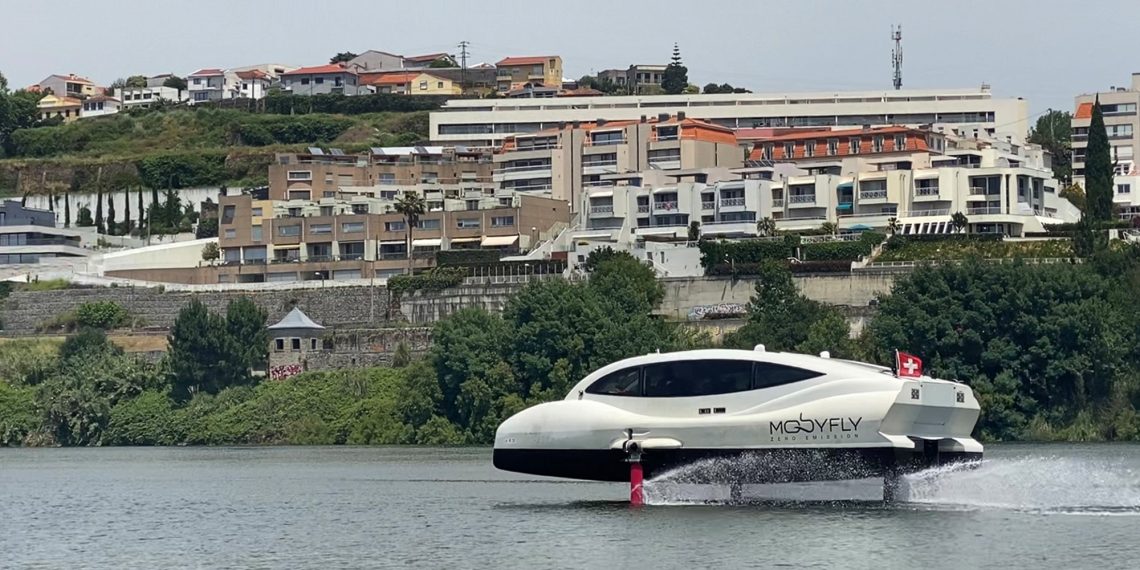Portugal is producing a zero-emission passenger ferry that is up to 80% more efficient than any current diesel ferry operating today: the MobyFly with its prototype MBFY10. This vessel’s efficiency is achieved using a hydrofoil system—a device similar to an aircraft wing— and advanced fly-by-wire software installed on the boat. The foils reduce hydrodynamic drag, allowing the vessel to “fly” above the water surface and achieve high speed with low energy consumption. For over two years, MobyFly has partnered with INESC TEC has partnered with MobyFly, Catana Group Portugal, and Corvus in the European FLYPASS Project to integrate advanced Corvus battery system technology and INESC TEC’s automatic-docking system into MobyFly’s ecosystem.
Maritime transport is responsible for more than 3% of global CO2 emissions. The total emissions of this sector are expected to increase, with projections indicating emissions will reach 5% of global output by 2050. The threat of climate change was the impetus behind the creation of a more sustainable hydrodynamic vessel for passenger transport, one using cutting-edge technologies of automatic docking and charging system, electric motors, batteries, and advanced control systems—to optimize performance and energy efficiency— and advanced foiling technology. This initiative sees Portugal assuming a leading role in the production of electric passenger ferries, offering unique, effective, and zero-emission solutions.
“What makes this prototype unique is the integration and combination of multiple technologies. The vessel, dedicated to passenger transport, is based on a robust and safe structure with minimal weight and, at the same time, uses a foiling system designed by Mobyfly,” says Bruno Ferreira, a researcher at INESC TEC, emphasising that “the vessel also uses an electric propulsion system allied to energy management technology, through fast battery charging and the development of exclusive battery modules, to meet all the energy and operational needs of the boat, in terms of speed and autonomy.”
“We’ve brought together the best of competitive marine technology and applied it to waterborne transportation, making high-performance, energy-efficient boats finally available to the fast ferry market,” says Sue Putallaz, co-founder and CEO of MobyFly. “We are now striving to produce this technology at an industrial scale and make it accessible to transport operators” add Ricardo Bencatel, co-founder and CTO.
“This project embodies maritime innovation, combining electric propulsion and foiling technology. We have not only pushed the boundaries of energy efficiency but also set a new standard for future passenger ferries, creating a zero-emission vessel that is both high-performing and sustainable” says Antoine Maillot, managing director of Catana Group Portugal.
MobyFly has designed its MBFY10 prototype since 2022. The MBFY10 has been further developed as part of the FLYPASS project to test the integration of the foiling control system, automatic docking system, and advanced battery system. With all tests completed, the project moves on to the commercial manufacture of the pre-series vessels.
With the first customer confirmed with a signed contract, the newest version of the vessel will be produced as a pre-series production line in Portugal. The updated battery system is already in development by Corvus, one of the project partners. This is only possible with the creation and consolidation of research and design teams that come together to innovate.
This project was funded through the EEA Grants.
About EEA Grants
Through the Agreement on the European Economic Area (EEA), Iceland, Liechtenstein and Norway are partners in the internal market with the Member States of the European Union.
As a way of promoting a continuous and balanced strengthening of economic and trade relations, the parties to the EEA Agreement have established a multi-annual Financial Mechanism, known as the EEA Grants.
The EEA Grants aim to reduce social and economic disparities in Europe and strengthen bilateral relations between these three countries and the beneficiary countries.
For the 2014-2021 period, a total contribution of 2.8 billion euros has been agreed for 15 beneficiary countries. Portugal will receive 102.7 million euros.
Find out more at eeagrants.gov.pt
The researcher mentioned in this news piece is associated with INESC TEC.



 News, current topics, curiosities and so much more about INESC TEC and its community!
News, current topics, curiosities and so much more about INESC TEC and its community!